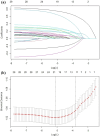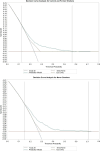Comprehensive Nomograms Using Routine Biomarkers Beyond Eosinophil Levels: Enhancing Predictability of Corticosteroid Treatment Outcomes in AECOPD
- PMID: 38476472
- PMCID: PMC10929658
- DOI: 10.2147/JIR.S450447
Comprehensive Nomograms Using Routine Biomarkers Beyond Eosinophil Levels: Enhancing Predictability of Corticosteroid Treatment Outcomes in AECOPD
Abstract
Purpose: Patients with acute exacerbation of chronic obstructive pulmonary disease (AECOPD) exhibit heterogeneous responses to corticosteroid treatment. We aimed to determine whether combining eosinophil levels with other routine clinical indicators can enhance the predictability of corticosteroid treatment outcomes and to come up with a scoring system.
Patients and methods: Consecutive patients admitted with AECOPD receiving corticosteroid treatment between July 2013 and March 2022 at Beijing Chao-Yang Hospital were retrospectively analyzed. Data on patients' demographics, smoking status, hospitalization for AECOPD in the previous year, comorbidities, blood laboratory tests, in-hospital treatment and clinical outcomes were collected. Least absolute shrinkage and selection operator (LASSO) regression and backward logistic regression were used for predictor selection, and predictive nomograms were developed. The discrimination and calibration of the nomograms were assessed using the area under the receiver operating curve (AUC) and calibration plots. Internal validation was performed using the 500-bootstrap method, and clinical utility was evaluated using decision curve analysis (DCA).
Results: Among the 3254 patients included, 804 (24.7%) had treatment failure. A nomogram of eosinophils, platelets, C-reactive protein (CRP), low density lipoprotein cholesterol, prognostic nutritional index (PNI), hospitalization for AECOPD in the previous year, ischemic heart diseases and chronic hepatic disease was developed to predict treatment failure for patients with a smoking history. For patients without a smoking history, a nomogram of CRP, PNI, ischemic heart diseases and chronic hepatic disease was developed. Although the AUCs of these two nomograms were only 0.644 and 0.647 respectively, they were significantly superior to predictions based solely on blood eosinophil levels.
Conclusion: We developed easy-to-use comprehensive nomograms utilizing readily available clinical biomarkers related to inflammation, nutrition and immunity, offering modestly enhanced predictive value for treatment outcomes in corticosteroid-treated patients with AECOPD. Further investigations into novel biomarkers and additional patient data are imperative to optimize the predictive performance.
Keywords: chronic obstructive pulmonary disease; glucocorticoids; least absolute shrinkage and selection operator; prediction model.
© 2024 Feng et al.
Conflict of interest statement
The authors report no conflicts of interest in this work.
Figures





Similar articles
-
Emergency admission parameters for predicting in-hospital mortality in patients with acute exacerbations of chronic obstructive pulmonary disease with hypercapnic respiratory failure.BMC Pulm Med. 2021 Aug 6;21(1):258. doi: 10.1186/s12890-021-01624-1. BMC Pulm Med. 2021. PMID: 34362328 Free PMC article.
-
Development of a Diagnostic Nomogram to Predict CAP in Hospitalized Patients with AECOPD.COPD. 2023 Dec;20(1):224-232. doi: 10.1080/15412555.2023.2228903. COPD. 2023. PMID: 37403800
-
Analysis of risk factors and development of predictive model for acute myocardial injury in patients with acute exacerbation of chronic obstructive pulmonary disease.J Thorac Dis. 2025 Apr 30;17(4):1977-1990. doi: 10.21037/jtd-2024-1992. Epub 2025 Apr 27. J Thorac Dis. 2025. PMID: 40400939 Free PMC article.
-
Construction and validation of nomogram prediction model for risk of acute heart failure in patients with acute exacerbation of chronic obstructive pulmonary disease.Medicine (Baltimore). 2024 Jan 5;103(1):e36840. doi: 10.1097/MD.0000000000036840. Medicine (Baltimore). 2024. PMID: 38181256 Free PMC article.
-
A nomogram-based clinical prediction model for adverse clinical outcomes in non-HIV Pneumocystis jirovecii pneumonia patients.BMC Pulm Med. 2025 May 17;25(1):238. doi: 10.1186/s12890-025-03700-2. BMC Pulm Med. 2025. PMID: 40382550 Free PMC article.
Cited by
-
Treatable traits identified in Chinese patients hospitalized with AECOPD: A Multicenter Cohort Study.Int J Med Sci. 2025 Apr 13;22(9):2227-2236. doi: 10.7150/ijms.111294. eCollection 2025. Int J Med Sci. 2025. PMID: 40303489 Free PMC article.
-
Identification of Novel Lactylation-Related Biomarkers for COPD Diagnosis Through Machine Learning and Experimental Validation.Biomedicines. 2025 Aug 18;13(8):2006. doi: 10.3390/biomedicines13082006. Biomedicines. 2025. PMID: 40868258 Free PMC article.
-
Blood Eosinophil Stability Predicts Clinical Outcomes in Hospitalized Patients with Acute Exacerbations of COPD.Int J Chron Obstruct Pulmon Dis. 2025 Aug 22;20:2913-2923. doi: 10.2147/COPD.S536911. eCollection 2025. Int J Chron Obstruct Pulmon Dis. 2025. PMID: 40873466 Free PMC article.
References
-
- Global Initiative for Chronic Obstructive Lung Disease. Global strategy for the diagnosis, management, and prevention of chronic obstructive pulmonary disease; 2023. Available from: https://goldcopd.org/2023-gold-reports-2/. Accessed April 20, 2023.
LinkOut - more resources
Full Text Sources
Research Materials
Miscellaneous

